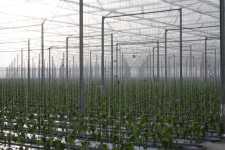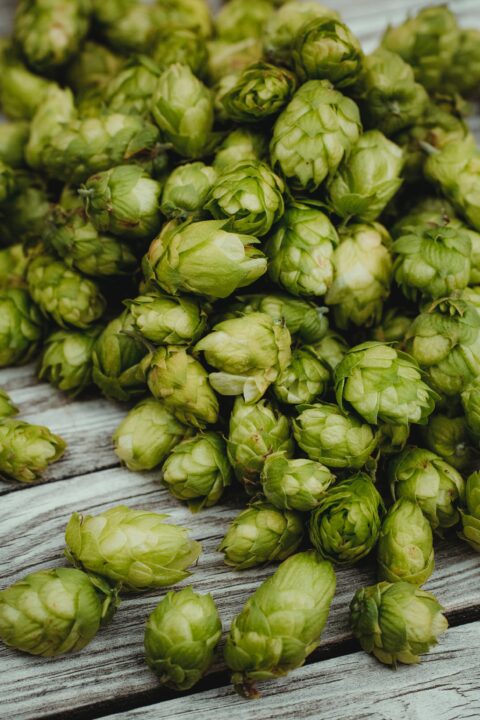Greenhouse Production Tips From The Netherlands


Just like in the U.S., peppers and tomatoes are popular greenhouse-grown vegetables in the Netherlands. While participating in Bayer CropScience’s Vegetable Future Forum in Germany in December, American Vegetable Grower had an opportunity to take a short trip to the Netherlands and tour two greenhouses. (For highlights on the Vegetable Future Forum, go to http://bit.ly/Z9zPoz.)
Like in the U.S., as well, Dutch greenhouse growers make sure they have a market for their crops, they strive to get a jump on the competition by offering product as early in the season as possible, and they try to keep the use of crop protectants to a minimum.
The first grower the group visited on the tour produced peppers in a 13.5-acre greenhouse. The second operation was growing tomatoes on the stem and plum tomatoes.
In the first facility toured by the group, which included several U.S. growers — Bill Brim of Lewis Taylor Farms in Georgia; Kent Hamilton of Hamilton Growers, also in Georgia; Alian Pincot of Bonipak in California, and Gary Tanimura, of Tanimura & Antle, also in California — the pepper crop had been in the greenhouses for just one week. It was pointed out by one of the tour guides, Wim Petersen, crop manager, horticulture, for Bayer CropScience in the Netherlands, that the greenhouse structures housing the plants are made from galvanized steel and can be sustained for up to 25 years.
Colorful Peppers
The pepper grower, Mark Litjens, is part of an association that consists of 40 growers, each growing peppers and working together to produce red, green, and yellow peppers. Those on the tour learned that to be involved in vegetable greenhouse production in the Netherlands, growers must be experts from the get-go. For example, they must know about the necessary permits, have the expertise to produce the crop, and know the ins and outs of marketing. Because the cost of production is high, there is no room for mistakes, added Petersen.
Litjens uses a hydroponic system to grow peppers using recycled rockwool. One of the main pests he encounters is thrips, which he tries to control via beneficial insects. In the past, there was zero tolerance to thrips, but now many greenhouse growers accept a threshold of thrips as some pressure is needed for the beneficial insects to work. According to Petersen, in a typical greenhouse in the Netherlands, the normal application of crop protectants is foliar but the preferred application method is through drip irrigation.
Lots Of Labor
Like in the U.S., labor is not cheap. About 2,500 hours of labor are needed to produce 1 acre of peppers. The labor usually comes in the form of students who earn about 7 euros (which is about $9) per hour.
The three main labor activities include wiring, trimming, and harvesting. The plants have to spin (to get the proper lighting, as no artificial lighting is used) so a wire is wrapped around the plant, as it grows approximately 3 inches every week. This wiring process helps with harvest, keeping the plants in an upright position and allowing for four stems on each plant. The goal is to make the pepper plants branch out until they produce four stems, said Litjens. As the plants get larger and more branches occur, those branches are pruned.
In addition, the grower noticed that by pumping carbon dioxide (CO2) into the greenhouse, he was able to bump up yields by 10%. To help distribute the CO2 among the plants, plastic cubes located next to the rockwool are used to blow it through plastic sleeves.
Tomatoes Of Fresh Valley
A visit to Fresh Valley, also located in the Netherlands, highlighted the production of cherry tomatoes on the stem and plum tomatoes. Unlike the pepper facility, artificial light is used to help boost production.
According to a spokesperson at Fresh Valley, the company gets a jump on the market with the use of artificial lighting. Lights are typically turned on in the afternoon so they don’t confuse the bumble bees during pollination. The bees are released in the morning and the artificial lights are not turned on until they reenter their boxes.
After a crop is started, yellow sticky traps are used to monitor for whitefly. In February, the beneficial insects are brought in to keep the whiteflies at bay. The cost to use beneficials is about $5,000 per acre. Like the pepper crop, the tomatoes are produced in rockwool which is elevated off the ground and a gutter collects excess drain water. One plant is on the floor, which serves as a backup plant in case a plant dies, added Koen Van den Eynde, product manager, Bayer CropScience in Germany, who also served as a tour guide.
The tomatoes are pruned to only one or two stems per plant, and CO2 also is used to help increase yields. A gas engine provides electricity for cooling water and the CO2. The CO2 is distributed to the plants at night through a plastic pipe.
Elevated along the outer walls of the greenhouse were additional tomato plants from a nearby nursery. By placing the plants along the greenhouse walls, space is saved and tending to the plants is simplified as workers can stand on a moveable ladder.
“The plants’ white roots indicate no pythium,” added Van den Eynde. Root development can be stimulated by inducing water stress, which, in turn helps establish a strong root system, he explained.
Tomato Buyers
As Fresh Valley is able to offer tomatoes to the marketplace two months before the competition, they make purchase agreements for the year. So it comes as no surprise to learn that supply continuity is essential to the business. Customers will go to another supplier if Fresh Valley cannot produce, even for one week.
According to Fresh Valley, all packed tomatoes already have a buyer, and the company can deliver in Germany to virtually any supermarket. The price, however, depends on the client. As Fresh Valley produces specialty tomatoes to fill a niche market, the company usually can command higher prices.










